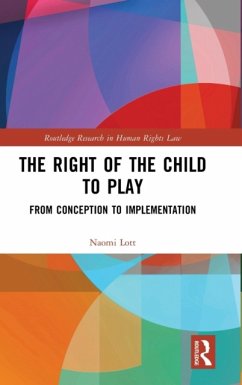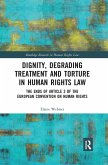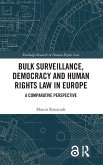- Gebundenes Buch
- Merkliste
- Auf die Merkliste
- Bewerten Bewerten
- Teilen
- Produkt teilen
- Produkterinnerung
- Produkterinnerung
This book provides a vital and original investigation into, and critique of, the situation facing the realisation of the childà â â s right to play. It offers an innovative insight into its value, the challenges facing the realisation of the right, its raison dà â â à ªtre and its scope, content and obligations.
Andere Kunden interessierten sich auch für
![The Protection of Vulnerable Groups under International Human Rights Law The Protection of Vulnerable Groups under International Human Rights Law]() Ingrid Nifosi-Sutton (USA American University Washington)The Protection of Vulnerable Groups under International Human Rights Law59,99 €
Ingrid Nifosi-Sutton (USA American University Washington)The Protection of Vulnerable Groups under International Human Rights Law59,99 €![The European Convention on Human Rights and the COVID-19 Pandemic The European Convention on Human Rights and the COVID-19 Pandemic]() Ronagh J.A. McQuigg (Ronagh McQuigg is a Senior Lecturer at Queen'sThe European Convention on Human Rights and the COVID-19 Pandemic31,99 €
Ronagh J.A. McQuigg (Ronagh McQuigg is a Senior Lecturer at Queen'sThe European Convention on Human Rights and the COVID-19 Pandemic31,99 €![Dignity, Degrading Treatment and Torture in Human Rights Law Dignity, Degrading Treatment and Torture in Human Rights Law]() Elaine Webster (UK University of Strathclyde)Dignity, Degrading Treatment and Torture in Human Rights Law54,99 €
Elaine Webster (UK University of Strathclyde)Dignity, Degrading Treatment and Torture in Human Rights Law54,99 €![Defamation and the Right to Freedom of Speech Defamation and the Right to Freedom of Speech]() Mariette JonesDefamation and the Right to Freedom of Speech154,99 €
Mariette JonesDefamation and the Right to Freedom of Speech154,99 €![Hate Speech and the European Court of Human Rights Hate Speech and the European Court of Human Rights]() Natalie Alkiviadou (Denmark. Justitia)Hate Speech and the European Court of Human Rights179,99 €
Natalie Alkiviadou (Denmark. Justitia)Hate Speech and the European Court of Human Rights179,99 €![The European Convention on Human Rights and the COVID-19 Pandemic The European Convention on Human Rights and the COVID-19 Pandemic]() Ronagh J.A. McQuiggThe European Convention on Human Rights and the COVID-19 Pandemic59,99 €
Ronagh J.A. McQuiggThe European Convention on Human Rights and the COVID-19 Pandemic59,99 €![Bulk Surveillance, Democracy and Human Rights Law in Europe Bulk Surveillance, Democracy and Human Rights Law in Europe]() Marcin RojszczakBulk Surveillance, Democracy and Human Rights Law in Europe154,99 €
Marcin RojszczakBulk Surveillance, Democracy and Human Rights Law in Europe154,99 €-
-
-
This book provides a vital and original investigation into, and critique of, the situation facing the realisation of the childà â â s right to play. It offers an innovative insight into its value, the challenges facing the realisation of the right, its raison dà â â à ªtre and its scope, content and obligations.
Produktdetails
- Produktdetails
- Routledge Research in Human Rights Law
- Verlag: Taylor & Francis Ltd
- Seitenzahl: 270
- Erscheinungstermin: 19. Mai 2023
- Englisch
- Abmessung: 240mm x 161mm x 19mm
- Gewicht: 516g
- ISBN-13: 9781032394220
- ISBN-10: 1032394226
- Artikelnr.: 67400934
- Herstellerkennzeichnung
- Libri GmbH
- Europaallee 1
- 36244 Bad Hersfeld
- gpsr@libri.de
- Routledge Research in Human Rights Law
- Verlag: Taylor & Francis Ltd
- Seitenzahl: 270
- Erscheinungstermin: 19. Mai 2023
- Englisch
- Abmessung: 240mm x 161mm x 19mm
- Gewicht: 516g
- ISBN-13: 9781032394220
- ISBN-10: 1032394226
- Artikelnr.: 67400934
- Herstellerkennzeichnung
- Libri GmbH
- Europaallee 1
- 36244 Bad Hersfeld
- gpsr@libri.de
Naomi Lott is an Economic and Social Research Council Postdoctoral Research Fellow of the Faculty of Law, and Early Career Fellow of the Bonavero Institute of Human Rights, University of Oxford, UK.
Foreword: The Right to Play - a Fundamental Children's Right of
Intergenerational Concern
Acknowledgements
1 Introduction
1.1 Introduction
1.2 Monograph Structure and Methodology
1.3 Definition of Play
1.3.1 Attempts at a Definition
1.3.2 The Difficulty of a Definition
1.3.3 The Committee on the Rights of the Child's Definition
1.4 Conclusion
2 The Importance of Play
2.1 Introduction
2.2 Cognitive Development
2.2.1 Literacy
2.2.2 Mathematics
2.2.3 Problem-Solving
2.2.4 Creativity
2.3 Social Development
2.4 Emotional Development
2.5 Physical Development
2.6 Enhancing Capabilities
2.7 Conclusion
3 Challenges to Be Overcome in Realising the Right to Play
3.1 Introduction
3.2 Safe Space for Play
3.2.1 Safe Environments
3.2.2 Access to Nature
3.2.3 Children's Use of Public Space
3.3 The Scholarisation of Childhood
3.4 Humanitarian and Development Programmes
3.4.1 Crises
3.4.2 Poverty
3.5 The Girl Child
3.6 Technology and Play
3.6.1 Physical and Mental Health - Time and Space for Play
3.6.2 Online Risks
3.6.3 Exposure to Violence
3.6.4 Cognitive Ability and Cultural Development
3.6.5 Commercialisation and Marketisation
3.7 Conclusion: The Lack of Recognition of the Importance of the Right to
Play
4 The Legal History of the Right to Play
4.1 Introduction
4.2 Travaux Préparatoires
4.2.1 The Drafting History of the Declaration on the Rights of the Child
4.2.2 From Declaration to Convention: The Drafting History of Article 31
4.3 The Committee on the Rights of the Child
4.3.1 The Committee's Forms of Output
4.3.2 The Legal Status of the Committee's Outputs
4.3.3 The Committee's Outputs and the Right to Play
4.4 Conclusion
5 The Scope and Content of the Right to Play
5.1 Introduction
5.2 Scope
5.3 Content
5.3.1 Indivisible, Interrelated, and Interdependent
5.3.2 "To Engage In"
5.3.3 'Appropriate to the Age of the Child'
5.3.4 AAAQ
5.4 Obligations Relating to the Right to Play
5.4.1 "To Undertake"
5.4.2 'All Appropriate Measures'
5.4.3 Maximum Extent of Available Resources
5.4.4 Progressive Realisation
5.4.5 Minimum Core
5.4.6 Non-Retrogression
5.4.7 International Cooperation
5.5 Conclusion
6 A Multiple-Case Study of the United Kingdom and Tanzania
6.1 Introduction
6.1.1 Method Choice and Justification
6.1.2 Country Choice and Justification
6.1.3 Interview Sample and Data Collection
6.2 Discussion of Findings
6.2.1 Legislation: Incorporation of the Right to Play
6.2.2 Political and Community Support
6.2.3 Education and Planning
6.3 Conclusion
7 Conclusion
7.1 A Note on the Coronavirus Pandemic
Bibliography
Index
Intergenerational Concern
Acknowledgements
1 Introduction
1.1 Introduction
1.2 Monograph Structure and Methodology
1.3 Definition of Play
1.3.1 Attempts at a Definition
1.3.2 The Difficulty of a Definition
1.3.3 The Committee on the Rights of the Child's Definition
1.4 Conclusion
2 The Importance of Play
2.1 Introduction
2.2 Cognitive Development
2.2.1 Literacy
2.2.2 Mathematics
2.2.3 Problem-Solving
2.2.4 Creativity
2.3 Social Development
2.4 Emotional Development
2.5 Physical Development
2.6 Enhancing Capabilities
2.7 Conclusion
3 Challenges to Be Overcome in Realising the Right to Play
3.1 Introduction
3.2 Safe Space for Play
3.2.1 Safe Environments
3.2.2 Access to Nature
3.2.3 Children's Use of Public Space
3.3 The Scholarisation of Childhood
3.4 Humanitarian and Development Programmes
3.4.1 Crises
3.4.2 Poverty
3.5 The Girl Child
3.6 Technology and Play
3.6.1 Physical and Mental Health - Time and Space for Play
3.6.2 Online Risks
3.6.3 Exposure to Violence
3.6.4 Cognitive Ability and Cultural Development
3.6.5 Commercialisation and Marketisation
3.7 Conclusion: The Lack of Recognition of the Importance of the Right to
Play
4 The Legal History of the Right to Play
4.1 Introduction
4.2 Travaux Préparatoires
4.2.1 The Drafting History of the Declaration on the Rights of the Child
4.2.2 From Declaration to Convention: The Drafting History of Article 31
4.3 The Committee on the Rights of the Child
4.3.1 The Committee's Forms of Output
4.3.2 The Legal Status of the Committee's Outputs
4.3.3 The Committee's Outputs and the Right to Play
4.4 Conclusion
5 The Scope and Content of the Right to Play
5.1 Introduction
5.2 Scope
5.3 Content
5.3.1 Indivisible, Interrelated, and Interdependent
5.3.2 "To Engage In"
5.3.3 'Appropriate to the Age of the Child'
5.3.4 AAAQ
5.4 Obligations Relating to the Right to Play
5.4.1 "To Undertake"
5.4.2 'All Appropriate Measures'
5.4.3 Maximum Extent of Available Resources
5.4.4 Progressive Realisation
5.4.5 Minimum Core
5.4.6 Non-Retrogression
5.4.7 International Cooperation
5.5 Conclusion
6 A Multiple-Case Study of the United Kingdom and Tanzania
6.1 Introduction
6.1.1 Method Choice and Justification
6.1.2 Country Choice and Justification
6.1.3 Interview Sample and Data Collection
6.2 Discussion of Findings
6.2.1 Legislation: Incorporation of the Right to Play
6.2.2 Political and Community Support
6.2.3 Education and Planning
6.3 Conclusion
7 Conclusion
7.1 A Note on the Coronavirus Pandemic
Bibliography
Index
Foreword: The Right to Play - a Fundamental Children's Right of
Intergenerational Concern
Acknowledgements
1 Introduction
1.1 Introduction
1.2 Monograph Structure and Methodology
1.3 Definition of Play
1.3.1 Attempts at a Definition
1.3.2 The Difficulty of a Definition
1.3.3 The Committee on the Rights of the Child's Definition
1.4 Conclusion
2 The Importance of Play
2.1 Introduction
2.2 Cognitive Development
2.2.1 Literacy
2.2.2 Mathematics
2.2.3 Problem-Solving
2.2.4 Creativity
2.3 Social Development
2.4 Emotional Development
2.5 Physical Development
2.6 Enhancing Capabilities
2.7 Conclusion
3 Challenges to Be Overcome in Realising the Right to Play
3.1 Introduction
3.2 Safe Space for Play
3.2.1 Safe Environments
3.2.2 Access to Nature
3.2.3 Children's Use of Public Space
3.3 The Scholarisation of Childhood
3.4 Humanitarian and Development Programmes
3.4.1 Crises
3.4.2 Poverty
3.5 The Girl Child
3.6 Technology and Play
3.6.1 Physical and Mental Health - Time and Space for Play
3.6.2 Online Risks
3.6.3 Exposure to Violence
3.6.4 Cognitive Ability and Cultural Development
3.6.5 Commercialisation and Marketisation
3.7 Conclusion: The Lack of Recognition of the Importance of the Right to
Play
4 The Legal History of the Right to Play
4.1 Introduction
4.2 Travaux Préparatoires
4.2.1 The Drafting History of the Declaration on the Rights of the Child
4.2.2 From Declaration to Convention: The Drafting History of Article 31
4.3 The Committee on the Rights of the Child
4.3.1 The Committee's Forms of Output
4.3.2 The Legal Status of the Committee's Outputs
4.3.3 The Committee's Outputs and the Right to Play
4.4 Conclusion
5 The Scope and Content of the Right to Play
5.1 Introduction
5.2 Scope
5.3 Content
5.3.1 Indivisible, Interrelated, and Interdependent
5.3.2 "To Engage In"
5.3.3 'Appropriate to the Age of the Child'
5.3.4 AAAQ
5.4 Obligations Relating to the Right to Play
5.4.1 "To Undertake"
5.4.2 'All Appropriate Measures'
5.4.3 Maximum Extent of Available Resources
5.4.4 Progressive Realisation
5.4.5 Minimum Core
5.4.6 Non-Retrogression
5.4.7 International Cooperation
5.5 Conclusion
6 A Multiple-Case Study of the United Kingdom and Tanzania
6.1 Introduction
6.1.1 Method Choice and Justification
6.1.2 Country Choice and Justification
6.1.3 Interview Sample and Data Collection
6.2 Discussion of Findings
6.2.1 Legislation: Incorporation of the Right to Play
6.2.2 Political and Community Support
6.2.3 Education and Planning
6.3 Conclusion
7 Conclusion
7.1 A Note on the Coronavirus Pandemic
Bibliography
Index
Intergenerational Concern
Acknowledgements
1 Introduction
1.1 Introduction
1.2 Monograph Structure and Methodology
1.3 Definition of Play
1.3.1 Attempts at a Definition
1.3.2 The Difficulty of a Definition
1.3.3 The Committee on the Rights of the Child's Definition
1.4 Conclusion
2 The Importance of Play
2.1 Introduction
2.2 Cognitive Development
2.2.1 Literacy
2.2.2 Mathematics
2.2.3 Problem-Solving
2.2.4 Creativity
2.3 Social Development
2.4 Emotional Development
2.5 Physical Development
2.6 Enhancing Capabilities
2.7 Conclusion
3 Challenges to Be Overcome in Realising the Right to Play
3.1 Introduction
3.2 Safe Space for Play
3.2.1 Safe Environments
3.2.2 Access to Nature
3.2.3 Children's Use of Public Space
3.3 The Scholarisation of Childhood
3.4 Humanitarian and Development Programmes
3.4.1 Crises
3.4.2 Poverty
3.5 The Girl Child
3.6 Technology and Play
3.6.1 Physical and Mental Health - Time and Space for Play
3.6.2 Online Risks
3.6.3 Exposure to Violence
3.6.4 Cognitive Ability and Cultural Development
3.6.5 Commercialisation and Marketisation
3.7 Conclusion: The Lack of Recognition of the Importance of the Right to
Play
4 The Legal History of the Right to Play
4.1 Introduction
4.2 Travaux Préparatoires
4.2.1 The Drafting History of the Declaration on the Rights of the Child
4.2.2 From Declaration to Convention: The Drafting History of Article 31
4.3 The Committee on the Rights of the Child
4.3.1 The Committee's Forms of Output
4.3.2 The Legal Status of the Committee's Outputs
4.3.3 The Committee's Outputs and the Right to Play
4.4 Conclusion
5 The Scope and Content of the Right to Play
5.1 Introduction
5.2 Scope
5.3 Content
5.3.1 Indivisible, Interrelated, and Interdependent
5.3.2 "To Engage In"
5.3.3 'Appropriate to the Age of the Child'
5.3.4 AAAQ
5.4 Obligations Relating to the Right to Play
5.4.1 "To Undertake"
5.4.2 'All Appropriate Measures'
5.4.3 Maximum Extent of Available Resources
5.4.4 Progressive Realisation
5.4.5 Minimum Core
5.4.6 Non-Retrogression
5.4.7 International Cooperation
5.5 Conclusion
6 A Multiple-Case Study of the United Kingdom and Tanzania
6.1 Introduction
6.1.1 Method Choice and Justification
6.1.2 Country Choice and Justification
6.1.3 Interview Sample and Data Collection
6.2 Discussion of Findings
6.2.1 Legislation: Incorporation of the Right to Play
6.2.2 Political and Community Support
6.2.3 Education and Planning
6.3 Conclusion
7 Conclusion
7.1 A Note on the Coronavirus Pandemic
Bibliography
Index








